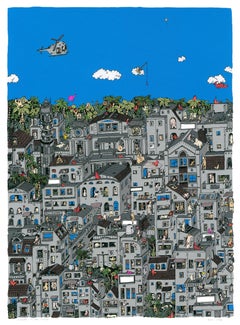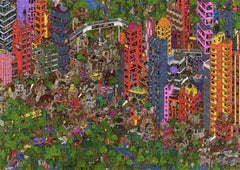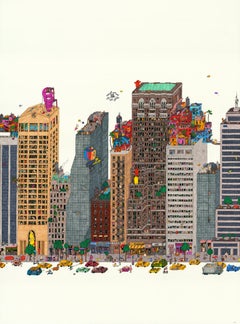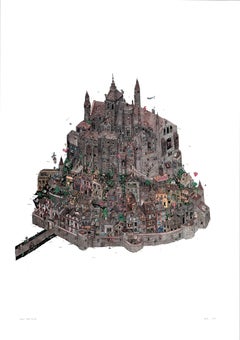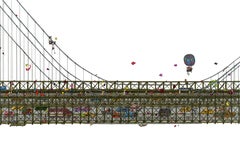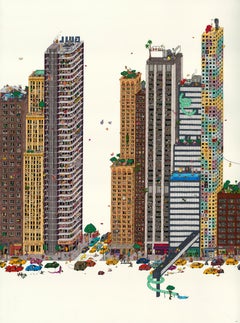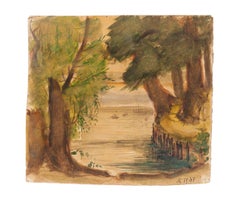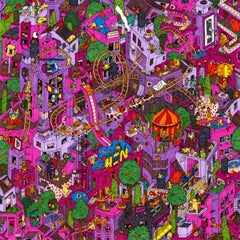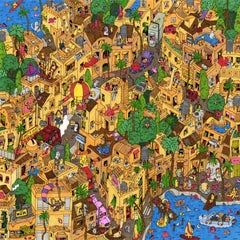Guillaume Cornet Art
Guillaume Cornet is an artist working with illustration and painting, exploring notions of abstract geometry, influenced by surreal perspectives plus architecture to construct sometimes monochrome but mostly colorful and vibrant visual spaces. His works tend to be filled with intricate characters positioning themselves in unexpected geometrical environments. Creating a humorous visual language, he frequently depicts unusual and bizarre situations. “As an Illustrator, I have always worked with Characters/Creatures to communicate my inner thoughts, ideas, emotions and situations. At some point, I wanted to create an environment for my creatures to grow, a place where I could let my imagination conquer the entire paper. I decided to push my limits by combining large format illustration, with extreme detail and precision. Uniting the things in life that inspire me the most: Places + People. Most of the Cityscape and Favela Series are inspired by densely populated areas from cities, which I have visited in South America, along with my personal experience from cities, where I have lived and worked: Paris, London, Lima and Barcelona. The characters are based on people and situations I come across in my daily life. But also by unusual sounds, objects, misunderstandings and the world, which revolves around me. In this digital world, I have always preferred to work with traditional techniques and analog processes. Making each piece of work unique and keeping close contact with the material through each stage of the creative process.” Guillaume Cornet lives and works in London, UK. He is currently illustrating his first full book to be published in 2018 titled Elephants World Tour.
2010s Pop Art Guillaume Cornet Art
Watercolor, Permanent Marker, Screen, Mixed Media
2010s Pop Art Guillaume Cornet Art
Watercolor, Pen, Permanent Marker
2010s Pop Art Guillaume Cornet Art
Watercolor, Pen, Permanent Marker
2010s Pop Art Guillaume Cornet Art
Mixed Media, Watercolor, Permanent Marker, Screen
2010s Pop Art Guillaume Cornet Art
Watercolor, Permanent Marker, Pen
2010s Pop Art Guillaume Cornet Art
Watercolor, Pen, Permanent Marker
2010s Pop Art Guillaume Cornet Art
Watercolor, Pen, Permanent Marker
2010s Pop Art Guillaume Cornet Art
Watercolor, Pen, Permanent Marker
2010s Pop Art Guillaume Cornet Art
Watercolor, Pen, Permanent Marker
2010s Pop Art Guillaume Cornet Art
Watercolor, Pen, Permanent Marker
2010s Pop Art Guillaume Cornet Art
Watercolor, Pen, Permanent Marker
2010s Pop Art Guillaume Cornet Art
Watercolor, Pen, Permanent Marker
2010s Pop Art Guillaume Cornet Art
Watercolor, Pen, Permanent Marker
2010s Pop Art Guillaume Cornet Art
Watercolor, Pen, Permanent Marker
2010s Pop Art Guillaume Cornet Art
Mixed Media, Watercolor, Permanent Marker, Screen
2010s Contemporary Guillaume Cornet Art
Watercolor, Permanent Marker, Screen
2010s Pop Art Guillaume Cornet Art
Watercolor, Permanent Marker, Screen
2010s Pop Art Guillaume Cornet Art
Watercolor, Pen, Permanent Marker
2010s Pop Art Guillaume Cornet Art
Watercolor, Pen, Permanent Marker
2010s Pop Art Guillaume Cornet Art
Watercolor, Pen, Permanent Marker
2010s Pop Art Guillaume Cornet Art
Watercolor, Pen, Permanent Marker
1940s Guillaume Cornet Art
Watercolor, Cardboard
1960s Pop Art Guillaume Cornet Art
Paper, Permanent Marker
1980s Pop Art Guillaume Cornet Art
Paper, Ink, Permanent Marker
Early 2000s Pop Art Guillaume Cornet Art
Permanent Marker, Lithograph, Offset
1990s Pop Art Guillaume Cornet Art
Permanent Marker, Pencil
1950s Modern Guillaume Cornet Art
Paper, Watercolor
1980s Modern Guillaume Cornet Art
Paper, Screen
Mid-19th Century Modern Guillaume Cornet Art
Lithograph
2010s Pop Art Guillaume Cornet Art
Wood, Mixed Media, Permanent Marker, Screen
1970s Contemporary Guillaume Cornet Art
Screen
Early 20th Century Guillaume Cornet Art
Archival Paper
1970s Pop Art Guillaume Cornet Art
Paper, Watercolor, Lithograph
2010s Pop Art Guillaume Cornet Art
Watercolor, Pen, Permanent Marker
2010s Pop Art Guillaume Cornet Art
Watercolor, Pen, Permanent Marker
2010s Pop Art Guillaume Cornet Art
Watercolor, Pen, Permanent Marker
2010s Pop Art Guillaume Cornet Art
Watercolor, Pen, Permanent Marker
2010s Pop Art Guillaume Cornet Art
Watercolor, Pen, Permanent Marker
2010s Pop Art Guillaume Cornet Art
Watercolor, Pen, Permanent Marker
2010s Pop Art Guillaume Cornet Art
Mixed Media, Permanent Marker, Pen
2010s Pop Art Guillaume Cornet Art
Mixed Media, Watercolor, Permanent Marker, Screen
Guillaume CornetRed Zeppelin, fantastical jungle inspired cityscape by Guillaume Cornet framed, 2014
2010s Contemporary Guillaume Cornet Art
Watercolor, Permanent Marker, Screen
2010s Contemporary Guillaume Cornet Art
Watercolor, Permanent Marker, Screen
2010s Contemporary Guillaume Cornet Art
Watercolor, Permanent Marker, Screen
